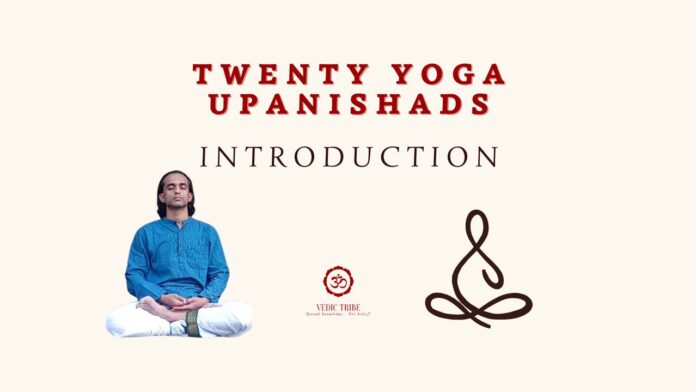What is the most ancient Yogic tradition of India?
Among the most ancient scriptures are undoubtedly the Vedas, to which numerous sub-scriptures were later added. One such ancient scripture, integral to the Vedic canon, is the Yoga Upanishads.
Foundation of Yogic tradition: These Yoga Upanishads offer a unique perspective on yogic practices and meditation techniques as practiced in ancient India. Notably, many of Upanishads align with the timeline of Patanjali’s Yoga Sutra and development of early Buddhism. Together they served as a crucial foundation for the development of the yogic tradition in India
Ancient practices: While many of these ancient practices have been lost to time, their remnants in Yoga Upanishads offer a fascinating glimpse into the rich history of yoga. In “Muktika” canon, 108 Upanishads are listed and among them twenty are Yoga Upanishads.
Common teachings:
Many common teachings amongst these 20 Yoga Upanishads can be found, which are essential part of not only Yogic tradition but also Tantric & Buddhist traditions:
1. Esoteric aspects of “Om” (Pranava)
2. Asana & pranayama (E.g. Padmasana, Ujjayi Pranayama…etc)
3. Chakra, Nadi and Kundalini shakti (E.g. Muladhara Chakra, Sushumna Nadi, Kundalini Yoga…etc)
4. Bandha, Mudra and other yogic practices (E.g. Mula Bandha, Shanmukhi Mudra, Pratyahara, Dharana…etc)
5. Specific meditation practices (E.g. Hamsa Vidya, Taraka Yoga…etc)
Patanjali Yoga tradition:
Sutra: Patanjali’s Yoga Sutra was compiled somewhere between 500 BCE to 300 CE. And most of the Yoga Upanishads were compiled little after this time period.
Tradition: It may be noted that though the scriptures were compiled after Patanjali’s Yoga Sutra, the yogic tradition itself pre-dates the said sutras and undoubtedly influenced Sage Patanjali. These ancient yogic traditions can be found in epics like Mahabharata and Puranas like Bhagavata. For example, in Mahabharata, amidst Kurukshetra war, Dronacharya sits for meditation to search for his son’s soul and gets his head chopped by Drushtadyumna. In Bhagavata Purana, voluntarily leaving the physical body using pranic power is explained in eighth chapter.
Ashtanga Yoga: Patanjali’s Ashtanga Yoga influenced the later Yoga Upanishads too. E.g. Patanjali’s Ashtanga Yoga model is directly seen in Darshana Upanishad and Varaha Upanishad.
In essence, Yogic tradition of Vedic times, Patanjali’s Yoga Sutra, Yoga Upanishads and later Buddhism should be considered integral part of the larger Yogic tradition of the land.
Tantra, Buddhism & Advaita:
Tantra canon: During 1st millennium CE, “Tantra Shastra” in the Vedic tradition was canonised and most of the teachings of Yoga Upanishads were incorporated and expanded in the said canons. E.g. Asana, Mudra, Bandha, Kundalini…etc.
Vajrayana Buddhism: Many teachings of Tantra Shastra were adopted by Vajrayana Buddhism and hence it was called “Tantra Yana”. Today these practices are found in Tibet, Nepal, Bhutan, and Mongolia. E.g. Maha mudra explained in Dhyanabindu & Yogachudamani Upanishads can be directly seen in Vajrayana Practices.
Advaita Vedanta: Teachings of Yoga Upanishads also influenced the development of Advaita Vedanta. For example, in Tejobindu Upanishad, third chapter contains verses “I am Parabrahma, I am the ultimate bliss”…etc.
Twenty Yoga Upanishads:
The Vedic Tribe is happy to introduce these twenty Yoga-Upanishads to revive interest in this ancient wisdom. By shedding light on these long-forgotten texts, we aim to inspire readers to delve deeper into the rich tapestry of yoga of Vedic tradition:
1. Hamsa Upanishad (1001–2000 CE)
2. Amritabindu Upanishad (100 BCE to 300 CE)
3. Amruta Nada Bindu Upanishad (100 BCE to 300 CE)
4. Kshurika Upanishad (100 BCE to 300 CE)
5. Tejobindu Upanishad (100 BCE to 300 CE)
6. Nadabindu Upanishad (100 BCE to 300 CE)
7. Dhyanabindu Upanishad (100 BCE to 300 CE)
8. Brahmavidya Upanishad (100 BCE to 300 CE)
9. Yogatattva Upanishad (100 BCE to 300 CE)
10. Trisikhibrahmana Upanishad (1 CE to 1000 CE)
11. Yogachudamani Upanishad (14th- to 15th-century CE)
12. Mandala-Brahmana Upanishad (1 CE to 1000 CE)
13. Advayataraka Upanishad (100 BCE to 300 CE)
14. Sandilya Upanishad (100 BCE to 300 CE)
15. Yogashikha Upanishad (100 BCE to 300 CE)
16. Pashupatabrahma Upanishad (classical era)
17. Yoga-Kundalini Upanishad (classical era)
18. Darshana Upanishad (100 BCE to 300 CE)
19. Mahavakya Upanishad (100 BCE to 300 CE)
20. Varaha Upanishad (1001–2000 CE)
In the next article, we will discuss “Hamsa Upanishad”.
Our intention is to create enough curiosity in you to enable you to study Upanishads and adopt its teachings in your day-to-day life.
All the best.
Madhwesh K
Vedic Tribe

